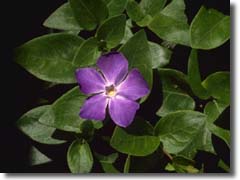
Members of Apocynaceae are perennial plants with simple, opposite leaves. The 5 lobed corolla forms a substantial tube, with 5 alternating stamens attached to the tube. The 5 lobed calyx is often separated almost to the base, and the single-style pistil is usally free or almost free from the calyx. As the 2 segment fruit develops, it splits apart to form separte pods that open after drying. Some species have a milky sap that can be toxic.
Although probably best known in our area by the european garden ground Vinca major - (Periwinkle) and the Oleander bush, Apocynaceae includes two species native to the Bay Area. Bitter Dogbane (Apocynum androsaemifolium.) and Indian Hemp (Apocynum cannabinum.) are found in some of the Bay Area counties. The fibrous stems of A. cannabinum. were used by Native Americans for making ropes and cords. Neither species has been found on Montara Mountain at this time.
Vinca major - (Periwinkle) is found throughout the lower elevations along trails, especially on the Pacifica side of the mountain.
